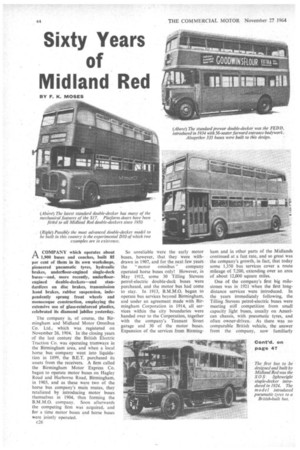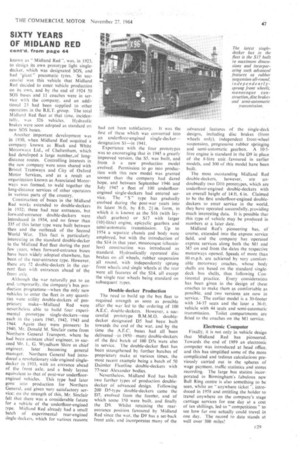Sixty Years of Midland Red
Page 46

Page 49

If you've noticed an error in this article please click here to report it so we can fix it.
BY F. K. MOSES
ACOMPANY which operates about 1,900 buses and coaches, built 85 per cent of them in its own workshops, pioneered pneumatic tyres, hydraulic brakes, underfloor-engined single-deck buses—and, more recently, underfloorengined double-deckers—and standardizes on disc brakes, transmission hand brakes, rubber suspension, independently sprung front wheels and monocoque construction, employing the extensive use of glass-reinforced plastics, celebrated its diamond jubilee yesterday.
The company is, of course, the Birmingham and Midland Motor Omnibus Co. Ltd., which was registered on November 26, 1904. In the closing years of the last century the British Electric Traction Co. was operating tramways in the Birmingham area, and when a local horse bus company went into liquidation in 1899, the B.E.T. purchased its assets from the receivers. A firm called the Birmingham Motor Express Co.• began to operate motor buses on Hagley Road and Harborne Road, Birmingham, in 1903, and as these were two of the horse bus company's main routes, they retaliated by introducing motor buses themselves in 1904, thus forming the B.M.M.O. company. Soon afterwards the competing firm was acquired, and for a time motor buses and horse buses were jointly operated.
c26
So unreliable were the early motor buses, however, that they were withdrawn in 1907, and for the next few years the "motor omnibus" company operated horse buses only! However, in May 1912, some 30 Tilling Stevens petrol-electric double-deck buses were purchased, and the motor bus had come to stay. In 1913, B.M.M.O. began to operate bus services beyond Birmingham, and under an agreement made with Birmingham Corporation in 1914, all services within the city boundaries were handed over to the Corporation, together with the company's Tennant Street garage and 30 of the motor buses. Expansion of the services from Birming
ham and in other parts of the Midlands continued at a fast rate, and so great was the company's growth, in fact, that today some 1,350 bus services cover a route mileage of 7,200, extending over an area of about 12,000 square miles.
One of the company's first big milestones was in 1921 when the first longdistance services were introduced. In the years immediately following, the Tilling Stevens petrol-electric buses were meeting stiff competition from small capacity light buses, usually on American chassis, with pneumatip tyres, and often owner-driven. • As there was no comparable British vehicle, the answer from the company, now familiarly
known as "Midland Red", was, in 1923, to design its own prototype light singledecker, which was designated SOS, and had "giant" pneumatic tyres. So successful was this vehicle that Midland Red decided to enter vehicle production on its own, and by the end of 1924 50 SOS buses and 11 coaches were in service with the company, and an additional 23 had been supplied to other operators in the B.E.T. group, The total Midland Red fleet at that time, w as 326 vehicles.' Hydraulic brakes were soon adopted as standard on new SOS buses.
Another important development was in 1930, when Midland Red acquired a company known, as Black and White Motorways Ltd., of Cheltenham, which had developed a large number.of longdistance routes. Controlling interests in the new company were soon shared with Bristol Tramways and City of Oxford Motor Services, and as a result an organization known as Associated Motorways was formed, to Weld together the long-distance services of other operators in various parts of the country. Construction of buses in the Midland Red works extended to double-deckers in 1932: these had rear entrances, but forward-entrance double-deckers were introduced in 1934, and no fewer than 335 of this latter type were built between then and the outbreak of the Second World War. This fact is particularly interesting as the standard double-decker in the Midland Red fleet during the past few years. when forward-entrance buses have been widely adopted elsewhere, has been of the rear-entrance type. However, there are 52 double-deckers in the current fleet with entrances ahead of the front axle, Although the war naturally put to an end, temporarily, the ompany's bus production programme—when the only new vehicles to enter the fleet in any quantities were utility double-deckers of proprietary make—Midland Red were nevertheless able to build four experimental prototype single-deckers--one each in the y ears 1941, 1942, 1943 and 1944. Again they were pioneers: In 1940, Mr. Donald M. Sinclair came from Northern General Transport, where he had been assistant chief engineer, to succeed Mr, L. G. Wyndham Shire as chief engineer, later . becoming general manager, Northern General had introduced a revolutionary side-cngined singledecker in 1933, with an entrance ahead of the front axlc, and a body layout equivalent to that of post-war underfloorengine(' vehicles. This type had later gone into production for Northern General, and given very satisfactory service; on the strength of this, Mr. Sinclair felt that there was a considerable future for a vehicle of the underfloor-engined type. Midland Red already had a small batch of experimental rear-erigined ;ingle-deckers, which for various reasons had not been satisfactory. It was the first of these which was converted into an underfloor-engined single-decker--designation S1—in 1941, Experience with the four prototypes was so encouraging that in 1945 a greatly improved version, the S5, was built, and from it a new production model evolved. Permission to go into production with this new model was granted sooner than the company had dared hope, and between September 1946 and July 1947 a fleet of 100 underfloorengined single-deckers had entered service. The "S" type has gradually evolved during the post-war years into its latest 36 ft. by 8 ft. 23in. form, in which it is known as the S16 (with layshaft gearbox) or S17 with larger (101-litre) engine, epicyclic gearbox and serni-automatic transmission. Up to 1954.a separate chassis and body were employed, but with the introduction of the S14 in that year, monocoque (chassisless) construction was introduced as standard. Hydraulically operated disc brakes on all wheels, rubber suspension all round, with independently sprung front wheels and single wheels at the rear were all features of the S14, all except the single rear wheels being standard on subsequent types.
Double-decker Production
The need to build up the bus fleet to required strength as soon as possible after the war led to the ordering of 100 A.E.C. double-deckers. However, a successful prototype B.M.M.O. doubledecker designated D5 had been built towards the end of the war, and by the time the A.E.C. buses had all been delivered—in 1950—many double-deckers of the first batch of 1430 D5s were also in service. The double-decker fleet has been strengthened by further batches of proprietary make at various times, the most recent example being a batch of 50 Daimler Fleetline double-deckers with 77-seat Alexander bodies.
Nevertheless, Midland Red has built two further types of production doubledecker of advanced design. Following 200 D5-type double-deckers came the D7. evolved from the fornter, and of which some 350 were built, and finally the D9. Whilst retaining the rearentrance position favoured by Midland Red since the war, the D9 has a set-back front axle, and incorporates many of the advanced . features of the single-deck designs, including disc brakes (front wheels only), independent -front-wheel suspension, progressive rubber springing and semi-automatic gearbox. A 10'Slitre engine is standard in the D9 in place of the 8-litre unit -favoured in earlier models, and 300 of this model have been built.
The most outstanding Midland Red double-deckers, however, are undoubtedly two DIO prototypes, which are underfloor-engineddouble-deckers with an overall height of 14 ft. 6 in. Claimed to be the first underfloor-engined doubledeckers to enter service in the world, they have operated successfully, providing much interesting data. It is possible that this type of vehicle may be produced in
numbers at a later date. .
Midland Red's pioneering has, of course, extended into the express service field, and the company has operated express services along both the Ml and M.5 on and from the dates the respective. motorways opened. Speeds of more than 80 mph. are achieved by very comfortable Motorway coaches, whose body shells are based on the standard singledeck bus shells, thus following Continental practice. Every consideration has been given in the 'design of these coaches to make them as comfortable as possible, and two versions are now in service.The earlier model is a 30-footer with 34-37 seats and the later a 36-ft. vehicle with 44 seats and semi-automatic transmission. Toilet compartments are fitted to the coaches on the MI service.
Electronic Computer
Finally, it is not only in vehicle design that Midland Red has pioneered. Towards the end of 1959 an electronic computer was introduced at head office. and this has simplified some of the more complicated and tedious calculations previously carried out in the spheres of wage payment, traffic statistics and stores recording. The large bus station incorporated in Birmingham's fabulous new Bull Ring centre is also something to be seen, whilst an anywhere ticket ". introduced in 1958 and entitling the holder to travel anywhere on the company's stage carriage services for one day at a cost of ten shillings, led to "competitions" to see how far one actually could travel in one day. The record to date stands at well over 300 miles!
















































































































